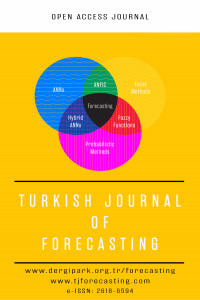Forecasting of Onion Sown Area and Production in Turkey Using Exponential Smoothing Method
Forecasting of Onion Sown Area and Production in Turkey Using Exponential Smoothing Method
In 2017, 144 countries in the world produced 97.862.928 tons onion at 5.201.591 hectares. Turkey produced 2.1 million tons onion in 68 thousand hectares. Turkey was the seventh-largest producer country of dry onion with a share of 2,18% in the world. The main aim of this research was to forecast the onion area and production of Turkey for the period of 2019-2026. The data of this study was obtained from the database of the Food and Agriculture Organization and the time series covered the period of 1961-2018. Three Exponential Smoothing Methods were compared to model onion area and production and Holt Exponential Smoothing model was determined as the most appropriate forecasting model. In the study, time series data were determined as non-stationary and so, stationarity was obtained after taking the first difference of the time series. Model results show that, in the 2019-2026 period, the forecasted sown area of onion would be increased from 58.873 hectares to 60.981 hectares, forecasted production of onion would be increased from 2.066.453 tons to 2.309.751 tons. In order to reduce the effect of Cobweb theorem, onion production should be planned by producer organizations. The supply gap can be avoided by taking appropriate policy measures and this is necessary to maintain Turkey’s position in the world onion market.
Keywords:
Onion Production, Sown area, Exponential Smoothing Method, Turkey,
___
- [1] NOA, (2019). National Onion Association, https://www.onions-usa.org/all-about-onions/onion-health-research (Accessed: 06.10.2019).
- [2] FAO, (2019). Food and Agricultural Organization, http://www.fao.org/faostat/en/#data/QC (Accessed: 05.10.2019)
- [3] MoAF, Ministry of Agriculture and Forestry, “Dry Onion Agricultural Products Markets, July 2018 Report”, (2018).
- [4] H.G. Doğan and Z. Gürler, “Implementation on an Agricultural Product Selected of Aconometric Model Distributed Lag (Almon Model Sample of Dry Onion)”, Akademik Bakış Dergisi, vol. 39, (2013), pp. 1-12.
- [5] E. Şimşek, “Analysis of Production and Price Relation of Growing Onion with Almon Approach: Amasya Case”, Turkish Journal of Agricultural and Natural Science, vol. 3, no. 2, (2016), pp. 118-125.
- [6] G. Erdal and H. Erdal, “The Interaction Between Production and Prices for Dry Onion”, GOÜ Ziraat Fakültesi Dergisi, vol. 25, no. 1, (2008), pp. 33-39.
- [7] S.A. Adil, A. Maqdood, K. Bakhsh and S. Hassan, “Forecasting Demand and Supply of Onion in Pakistani Punjab”, Pakistan Journal of Agricultural Science, vol. 49, no. 2, (2012), pp. 205-210.
- [8] Y. Zhu, Y. Zhao, J. Zhang, N. Geng, D. Huang, “Spring Onion Seed Demand Forecasting Using a Hybrid Holt-Winters and Support Vector Machine Model”, Plos One, vol. 14, no. 7, (2019), pp. 1-18.
- [9] X. Li, “Comparison and Analysis between Holt Exponential Smoothing and Brown Exponential Smoothing Used for Freight Turnover Forecasts”, Third International Conference on Intelligent System Design and Engineering Applications, (2013), IEEE.DOİ: 10.1109/ISDEA.2012.112
- [10] Jr. ES. Gardner and E. Mckenzie, “Forecasting Trends in Time series. Management Science”, vol. 31, no. 10, (1985), pp. 1237–1246.
- [11] S. Makridakis, S.C. Wheelwright and R.J. Hyndman, “Forecasting: Methods: and Applications”, 3th Edition, John Wiley and Sons. Inc., United State of America (1998).
- [12] I. Akgül, “Geleneksel Zaman Serisi Yöntemleri”, Der Yayınevi, İstanbul. (2003).
- [13] D.C. Montgomery, C.L. Jennings, M. Kulahci, “Introduction to Time Series Analysis and Forecasting” Published by John Wiley &Sons.Inc., New Jersey, (2008).
- [14] F. Hancı, “A Comprehensive Overview of Onion Production: Worldwide and Turkey”, IOSR Journal of Agriculture and Veterinary Science, vol. 11, no. 1, (2018), pp. 17-27.
- Yayın Aralığı: Yılda 2 Sayı
- Başlangıç: 2017
- Yayıncı: Giresun Üniversitesi
